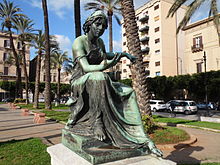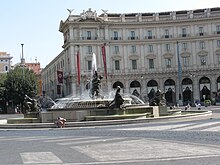Mario Rutelli

Mario Rutelli (born April 4, 1859 in Palermo , † November 4, 1941 ibid) was an Italian sculptor and bronze caster .
Life
Mario Rutelli's father was the architect Giovanni Rutelli, his mother's name was Vita Romano. In Palermo he received his first artistic training at the local art academy under Salvatore Valenti (1835–1903). He then worked as a stonemason for the Teatro Massimo in his hometown, in 1877 he worked under Benedetto Civiletti on the bronze lions and the allegorical female figures of the muses in front of the theater. In 1879 he went to Rome to see Giulio Monteverde and Ercole Rosa .
Back in Palermo, he and Civiletti worked on the Quadriga and several individual statues at the Teatro Politeama . In the same year he became director of the Fonderia Artistica in Palermo. In 1903 he received a chair for sculpture at the Real Istituto di Belle Arti.
He was married to Maria (nee Russo) and the couple had six children (Maria, Rosario, Giuseppina, Vita, Giovanni and Sesto).

Works (selection)
- Teatro Massimo (Palermo) : Allegorical bronze sculpture with lion "La Lirica" (lyric poetry) to the left of the outside staircase ("La Tragedia", German tragedy, right of the outside staircase is by Benedetto Civiletti ), "Apoteose des Vittorio Emanuele" and an allegorical female figure “Poetry” (1877).
- Piazza Giulio Cesare (Palermo): bronze equestrian statue “ Vittorio Emanuele II ” from 1886
- Piazza della Repubblica (Rome) : "Fontana delle Naiadi" (1901)
- Piazza Sforza Cesarini (Rome): Monument to Nicola Spedalieri (1903)
- Monreale : Fontane di Tritone (1905)
- Gianicolo (Rome): Monument to Anita Garibaldi
- Monumento Vittorio Emanuele II (Rome): a Victoria
- Teatro Politeama (Palermo) : Bronze sculpture group of the Quadriga (the two riders on the left and right of it are by Benedetto Civiletti ).
- Giardino Garibaldi (Palermo): relief with lions at the monument to Giuseppe Garibaldi
- Giardino Inglese : Several busts “ Domenico Morelli ”, “Giuseppe Maielli” and Edmondo De Amicis
- Palazzo Francavilla (Palermo): medallions of the Dukes of Sperlinga (together with Benedetto Civiletti)
- Catania : equestrian monument to Umberto I.
- Piazza Armerina: bust on a pedestal “King Umberto I”
- Agrigento : fountain and monument
- Basilica di Maria Santissima Annunziata ( Comiso ): font in bronze and marble (1913)
- Munich : Monument to Johann Wolfgang von Goethe
- Aberystwyth in Wales : Victory Column (22 m high) in memory of the dead of World War I.
literature
- Rutelli, Mario . In: Hans Vollmer (Hrsg.): General lexicon of fine artists from antiquity to the present . Founded by Ulrich Thieme and Felix Becker . tape 29 : Rosa – Scheffauer . EA Seemann, Leipzig 1935, p. 238 .
- Rutelli, Mario. In: Enciclopedia Italiana. 1936 (Italian, treccani.it ) and addendum 1943 (Italian, treccani.it )
- Sergio Troisi: Mario Rutelli, lo scultore che segnò la città borghese . In: La Repubblica . October 24, 2009 (Italian, ricerca.repubblica.it ).
- Francesco Santaniello: Rutelli, Mario. In: Raffaele Romanelli (ed.): Dizionario Biografico degli Italiani (DBI). Volume 89: Rovereto – Salvemini. Istituto della Enciclopedia Italiana, Rome 2017.
Web links
- Rutelli, Mario. In: Enciclopedie on line. Istituto della Enciclopedia Italiana, Rome. Retrieved August 28, 2016.
- Entry in the Archivio biografico comunale
| personal data | |
|---|---|
| SURNAME | Rutelli, Mario |
| BRIEF DESCRIPTION | Italian painter |
| DATE OF BIRTH | April 4, 1859 |
| PLACE OF BIRTH | Palermo |
| DATE OF DEATH | November 4, 1941 |
| Place of death | Palermo |

